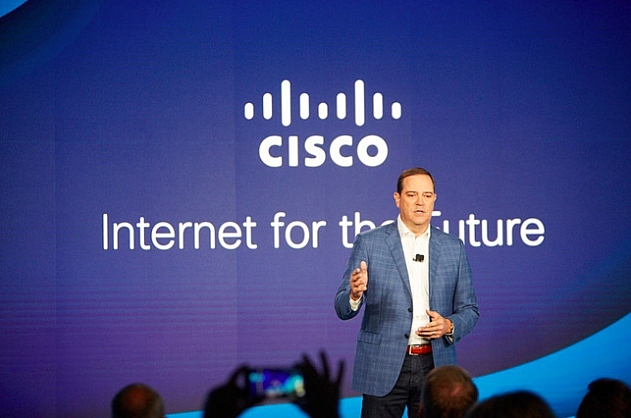Building internet for the next decade of digital innovation
 |
| Chuck Robbins, chairman and CEO of Cisco |
Cisco introduced its latest innovation including Cisco Silicon OneTM, the industry’s only networking silicon architecture of its kind; released the new Cisco 8000 Series, the world’s most powerful carrier class routers built on the new silicon; and announced new purchasing options that enable customers to consume the company’s technology through disaggregated business models.
“Innovation requires focused investment, the right team and a culture that values imagination," said Chuck Robbins, chairman and CEO of Cisco. "We are dedicated to transforming the industry to build a new internet for the 5G era. Our latest solutions in silicon, optics and software represent the continued innovation we're driving that helps our customers stay ahead of the curve and create new, ground-breaking experiences for their customers and end users for decades to come.”
Building blocks for the Internet for the future
Over the next decade, digital experiences will be created with advanced technologies — virtual and augmented reality, 16K streaming, AI, 5G, 10G, quantum computing, adaptive and predictive cybersecurity, intelligent IOT, and others not yet invented. These future generations of applications will drive complexity beyond the capabilities current internet infrastructure can viably support.
For the past five years, Cisco has driven a technology strategy that is building the internet our customers will need for the future success of their business in an advanced digital world. Aimed at solving the toughest problems that will emerge as digital transformation taxes current infrastructure to its breaking point, this strategy will lead to the next-generation of internet infrastructure that combines Cisco’s new silicon architecture with its next-generation of optics. Cisco’s strategy will change the economics behind how the internet will be built to support the demands of future, digital applications and will enable customers to operate their businesses with simpler, more cost-effective networks.
Cisco’s strategy is based on development and investments in three key technology areas: silicon, optics and software.
Introducing Cisco Silicon One – Breakthrough unified, programmable Silicon Architecture
The new Cisco Silicon One will be the foundation of Cisco’s routing portfolio going forward, with expected near-term performance availability up to 25 Terabits per second (Tbps). This
is the industry’s first networking chip designed to be universally adaptable across service provider and web-scale markets. Designed for both fixed and modular platforms, it can manage the most
challenging requirements in a way that’s never been done before. The first Cisco Silicon One ‘Q100’ model surpasses the 10 Tbps routing milestone for network bandwidth without sacrificing programmability, buffering, power efficiency, scale or feature flexibility.
Traditionally, multiple types of silicon with different capabilities are used across a network and even within a single device. Developing new features and testing can be lengthy and expensive. Unified and programmable silicon will allow for network operators to greatly reduce costs of operations and reduce time-to-value for new services.
“We look forward to working with Cisco as it enters the high-end routing silicon space, collaborating to help meet the next generation of network demands for higher speeds and greater capacity,” said Amin Vahdat, fellow and vice president of Systems Infrastructure, Google Cloud.
“Facebook has been a strong advocate for network disaggregation and open ecosystems, launching key industry initiatives such as the Open Compute Project and the Telecom Infrastructure Project to transform the networking industry,” said Najam Ahmad, vice president, Network Engineering at Facebook. “Cisco’s new Silicon One architecture is aligned with this vision, and we believe this model offers network operators diverse and flexible options through a disaggregated approach.”
“Cisco is changing the economics of powering the Internet, innovating across hardware, software, optics and silicon to help its customers better manage the operational costs to function on a larger scale for the next phase of the Internet,” said Ray Mota, CEO and principal analyst at ACG Research. “As we move to 2020, the timing of delivering operational efficiency will be vital.”
What the stars mean:
★ Poor ★ ★ Promising ★★★ Good ★★★★ Very good ★★★★★ Exceptional
Related Contents
Latest News
More News
- Acecook Vietnam: 30 years of creating happiness (January 08, 2026 | 08:00)
- Sustainability a core value for DKSH’s vision (January 07, 2026 | 16:00)
- People encouraged to contribute and grow at AstraZeneca Vietnam (January 07, 2026 | 15:48)
- Dat Bike accelerates sustainable mobility (January 07, 2026 | 15:24)
- Innovation to support modern healthcare development (January 07, 2026 | 10:00)
- Six localities record double-digit growth as regional performance diverges in 2025 (January 06, 2026 | 18:00)
- E-commerce market undergoes transformation amid rising competition and regulation (January 06, 2026 | 17:54)
- Vietnam’s industrial output hits seven-year high in 2025 (January 06, 2026 | 17:47)
- GELEX’s credit rating outlook upgraded to 'Positive' by VIS Rating (January 06, 2026 | 16:49)
- Finance sector lays firm groundwork for 2026 after major reform (January 06, 2026 | 15:30)

 Tag:
Tag:




















 Mobile Version
Mobile Version